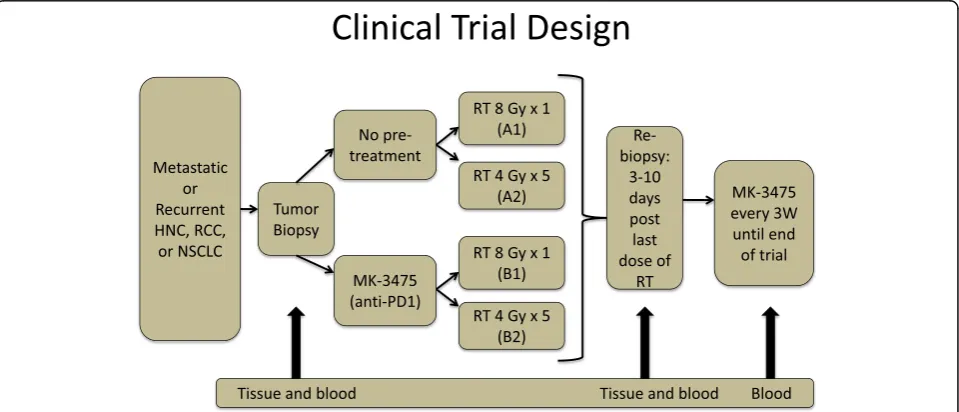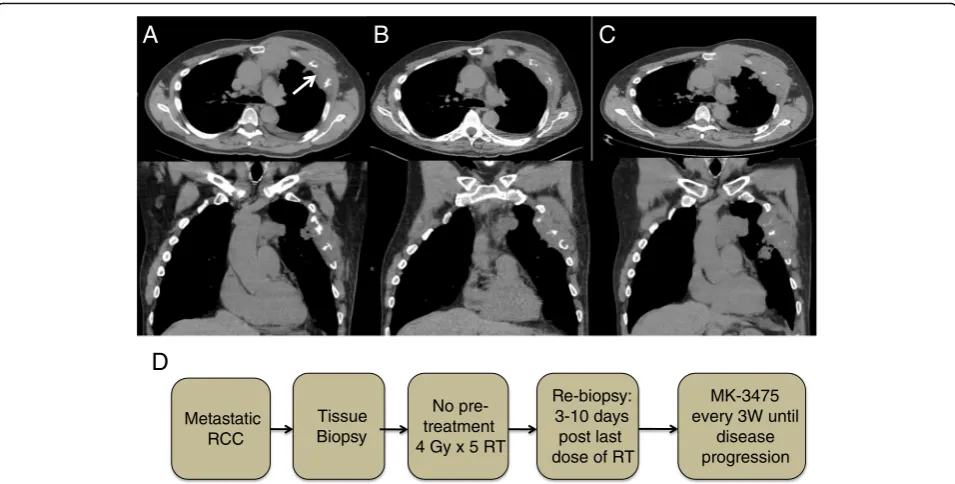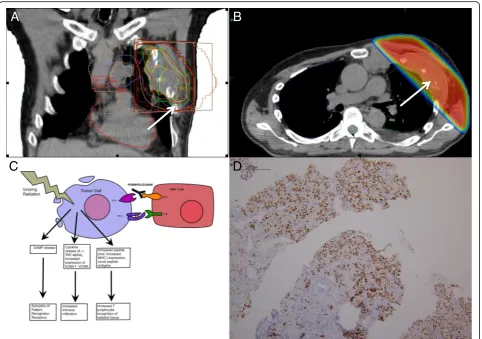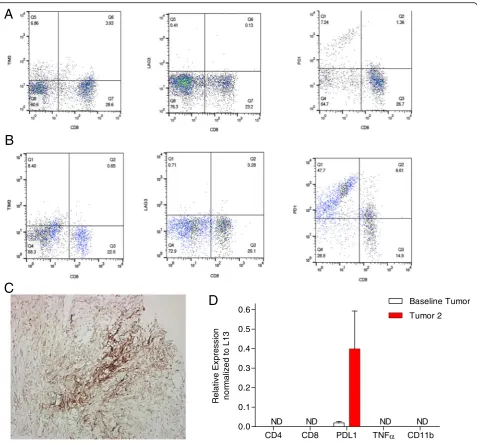C A S E R E P O R T
Open Access
Immune biomarkers of treatment failure for
a patient on a phase I clinical trial of
pembrolizumab plus radiotherapy
Gregory S. Alexander
1, Joshua D. Palmer
2, Madalina Tuluc
3, Jianqing Lin
4, Adam P. Dicker
2, Voichita Bar-Ad
2,
Larry A Harshyne
5, Jennifer Louie
2, Colette M. Shaw
6, D. Craig Hooper
5and Bo Lu
2*Abstract
Background:
Pembrolizumab is a monoclonal antibody that is designed against programmed cell death protein 1
(PD-1). Pembrolizumab and other immunocheckpoint-blocking monoclonal antibodies work by modulating a
patient
’
s own immune system to increase anti-tumor activity. While immunocheckpoint blockade has shown
promising results, only 20
–
40 % of patients experience objective clinical benefit. Differences in individual tumor
biology and the presence multiple immune checkpoints present a challenge for treatment. Because radiotherapy
has immunomodulatory effects on the tumor microenvironment, it has the potential to synergize with
immunotherapy and augment tumor response. NCT02318771 is a phase 1 clinical trial designed to investigate the
immunomodulatory effects of radiation therapy in combination with pembrolizumab.
Case presentation:
The patient is a 64-year-old male with metastatic clear cell renal cell carcinoma, Fuhrman grade
4, pathologically staged as T3 N0. Metastatic disease was well controlled for several years with sunitinib. Following
disease progression, he was switched to axitinib. When disease progression continued, the patient was enrolled in
NCT02318771, a phase 1 clinical trial combining radiotherapy and pembrolizumab. The patient experienced
unusually rapid disease progression during treatment, which was confirmed by repeated CT scans to rule out
pseudoprogression. Tissue biopsies and peripheral blood draws were obtained before, during, and after treatment.
Samples were analyzed to provide plausible rationale for rapid treatment failure.
Conclusions:
Biomarker analysis demonstrated an absence of TILs, which may be a cause of treatment failure as
pembrolizumab works through T cell-dependent mechanisms. Furthermore, the presence of other non-redundant
immune checkpoints in the periphery and tumor microenvironment presents a treatment challenge. Additionally,
the radiation dose and fractionation schedule may have played a role in treatment failure as these factors play a
role in the effect radiotherapy on the tumor microenvironment as well as the potential for synergy with
immunotherapy.
Trial registration:
An Exploratory Study to Investigate the Immunomodulatory Activity of Radiation Therapy (RT) in
Combination With MK-3475 in Patients With Recurrent/Metastatic Head and Neck, Renal Cell Cancer, Melanoma and
Lung Cancer, NCT02318771.
Keywords:
Pembrolizumab, Renal cell carcinoma, Radiotherapy, Immunotherapy, Case report
* Correspondence:Bo.Lu@jefferson.edu
Data presented in part at the Society for Immunotherapy of Cancer, November 4-November 8, 2015, National Harbor, MD. This manuscript has been submitted previously to Cancer Immunology Research.
2Department of Radiation Oncology, Bodine Center, Sidney Kimmel Medical
College at Thomas Jefferson University, 111 South 11th Street, Philadelphia, PA 19107, USA
Full list of author information is available at the end of the article
Background
Pembrolizumab (MK-3475; Pembro) is a humanized IgG4
monoclonal antibody that is directed against the
pro-grammed cell death protein 1 (PD-1). PD-1 is expressed
by T cells and interacts with its ligands programmed cell
death protein ligand 1 (PD-L1) and programmed cell
death protein ligand 2 (PD-L2), which are expressed in
peripheral tissues and dendritic cells, respectively. PD-L1
expression is variable and involved in the prevention of
autoimmunity; however, many tumors upregulate PD-L1
to mediate immune tolerance [1]. By blocking the PD-1
pathway, Pembro can enhance T cell-mediated killing of
tumor cells [2]. It has been approved for the treatment of
melanoma and non-small cell lung cancer; however, only
20
–
40 % of patients demonstrate clinical benefit with
monotherapy [3
–
5]. Radiation therapy (RT) is thought to
have immunostimulatory effects by enhancing cancer
anti-gen presentation [6, 7]. Because both modalities work
through immune-mediated mechanisms, combination
therapy has the potential to augment immune activation
by PD-1 checkpoint inhibitors. Preclinical models have
demonstrated synergy between RT and PD-1 blockade
treatments [8], and several clinical trials combining RT
with immunotherapy are underway [9]. A phase 1 clinical
trial (NCT02318771) was designed to investigate the
im-munomodulatory effects of RT/Pembro combination
treatment.
We report clinicopathologic and detailed flow cytometry
data from a patient with metastatic renal cell carcinoma
(RCC) who progressed through combined
immunother-apy and radiation.
Case presentation
A 64-year-old Caucasian gentleman presented with flank
pain and gross hematuria in February 2010. Initial
work-up demonstrated a left renal mass, and a left radical
nephrectomy confirmed clear cell RCC, Fuhrman grade
4, pathologically staged as T3 N0. Additionally, at
diag-nosis, small pulmonary nodules were found that were
later confirmed to be RCC by Pax-8 staining (Fig. 3d).
He was treated with sunitinib from March 2010 until
July 2013, when disease progression occurred. The
patient was then treated with axitinib, until progression
and the development of additional pulmonary nodules in
November 2014.
The patient was thereafter enrolled in a clinical trial
(NCT02318771). The trial schema is illustrated in Fig. 1.
The trial enrolls patients with metastatic lung cancer,
melanoma, head and neck cancer, or RCC. The primary
objective is to determine immune activation from single
dose 8 Gy vs. fractionated palliative radiotherapy (4 Gy
×5), which is either preceded by one cycle of Pembro or
followed by Pembro that continues until disease
progres-sion or grade 3 or greater toxicities. Our patient was
randomized to group A2, (Fig. 2d) in which he was given
a course of palliative RT dose (20 Gy in five fractions to
his left chest wall lesion), (Fig. 3a and b) followed by
adjuvant Pembro 200 mg once every 3 weeks
intraven-ously. After 5 cycles of treatment, CT scans in May 2015
(Fig. 2b) and a confirmatory scan in June 2015 (Fig. 2c)
revealed progression when compared to his baseline
scans taken in February 2015 (Fig. 2a). Patient tolerated
the combined therapy well without any toxicities and
Fig. 1Clinical trial schema. Patients with metastatic or recurrent head and neck cancer, renal cell carcinoma, or non-small cell lung cancer were randomized to either receive pembrolizumab pre-treatment or no pembrolizumab pre-treatment. Patients were again randomized to receive a single dose of 8 Gy of radiation or five doses of 4 Gy of radiation. Tumor biopsies were obtained at the beginning of the trial as well as 3–10 days following the last dose of RT. Following RT, all patients received 200 mg of pembrolizumab every 3 weeks
had no complaints of chest wall or sternal discomfort or
respiratory symptoms although imaging studies
demon-strated an increased size of the left chest wall lesion,
multiple bilateral pulmonary nodules, and an anterior
mediastinal mass accompanied with erosion of the
sternum and the third, fourth, and fifth ribs, as well as
new nodules that were not previously identified. As per
protocol, the patient was removed from trial following
disease progression. A biopsy of the chest wall lesion
was performed to rule out possible pseudoprogression.
Peripheral blood draws and tumor biopsies of his
target lesion were obtained before, after RT in early
March, and at the time of progression in late June. Flow
cytometry analysis of his circulating CD3
+T
lympho-cytes revealed a minor change in the proportion of CD8
+ lymphocytes from baseline (28 %) compared to
post-radiation (24 %) and post-Pembro treatment (24 %).
However, due to a decrease in the numbers of
circulat-ing CD3
+T cells from 1.2 × 10
6/ml before study to 0.9 ×
10
6/ml at the conclusion of the trial, there was an overall
reduction in the number of circulating CD8 T cells by
40 %. This was accompanied by a somewhat lesser 22 %
decrease in the numbers of circulating CD4+ T cells
post-Pembro. Over the course of treatment, PD1
expres-sion was strongly increased on subsets of circulating
CD8
+and CD8
−CD3
+T cells (Fig. 4a, b). Changes in
the expression of other immune checkpoint markers
including Tim-3 and Lag-3 were also assessed by flow
cytometry. Both were detected on circulating CD8+
cells, but there were no significant differences in
expres-sion between cells obtained before and after treatment
noted (Fig. 4a, b).
There was an absence of tumor-infiltrating
lympho-cytes (TILs) on tumor biopsy by histological analysis.
This finding was confirmed by RT-PCR analyses of
tumor biopsies, which failed to detect CD4 or CD8
tran-scripts (Fig. 4d). RT-PCR also failed to detect TNF-alpha
or CD11b transcripts before and after radiotherapy.
PD-L1 transcripts were strongly upregulated in biopsy tissue
following RT, which was confirmed by
immunohisto-chemistry (Fig. 4c).
Discussion
The investigational agent Pembro works through
antag-onism of PD-1 pathway on activated T cells. While PD-1
blockade monotherapy has led to impressive results
against some treatment resistant tumors [10], single
checkpoint blockade only produces an objective clinical
response in approximately 20
–
40 % of patients [3
–
5]. It
appears that PD-L1 expression may be predictive of
treatment response, but not all patients with
PD-L1-positive tumors respond [11]. Because there are multiple,
non-redundant mediators of immune tolerance in the
microenvironment, tumors may escape immune
surveil-lance through other pathways that are not disrupted by
Pembro [1].
Activated T cells may express multiple
immunomodu-latory cell surface receptors, such as TIM-3, LAG-3, and
CTLA-4 [12]. When these receptors are engaged by
their respective ligands, T cell activity is repressed. Flow
cytometry of peripheral blood mononuclear cells
re-vealed TIM-3 and Lag-3 expression on circulating T
lymphocytes, which suggests multiple pathways may
have been utilized by the metastatic growths to evade
the immune response. Preclinical animal models have
demonstrated increased efficacy when various
combina-tions of different immune checkpoint blockade and RT
are utilized when compared to monotherapy [8, 13
–
16].
Of note is the lack of TILs, which was confirmed by
RT-PCR and histological study and the 40 % decrease in
total circulating CD8-positive T cells. Because Pembro
acts through a T cell-dependent mechanism, a decrease
in circulating CD8s and a lack of TILs is a possible cause
for treatment failure [17]. The presence of TILs has been
shown to be predictive treatment response in both
melan-oma and mismatch repair-deficient colon cancer [18, 19],
but more work must be done to demonstrate predictive
value in other solid tumors [20]. The lack of TILs in this
patient may be attributed to a dysregulation of chemokine
secretion, resulting in a failure to attract migrating
lymphocytes into target tissue. This hypothesis is
supported by the failure of RT-PCR to detect TNF-alpha
transcripts in tumor biopsies before and after treatment as
TNF-alpha has a role in lymphocytic migration. The
Fig. 3aCoronal image of the radiation treatment planning CT depicting the treatment portal, organs at risk, and isodose lines. Thewhite arrow
points to the 20-Gy isodose line.bAxial image of the radiation treatment planning CT depicting the dose wash and dose falloff into the left lung.
Reddepicts the prescription isodose line of 20 Gy, which was given over five daily fractions. Thewhite arrowpoints to the 20-Gy isodose line.c
The immunomodulatory effects of ionizing radiation has the potential for synergism with pembrolizumab.dA tumor biopsy of chest wall lesion was stained with Pax-8 to confirm metastatic RCC
lengthy treatment with tyrosine kinase inhibitors, axitinib,
and sunitinib, may have also inhibited lymphocytic
infil-tration. Both drugs have been shown to have
immuno-modulatory effects that can disrupt the function of both T
cells and dendritic cells [21
–
24].
In addition to inducing apoptosis through free radical
damage, RT has the potential to enhance T cell
recogni-tion of malignant tissue through the inducrecogni-tion of
MHC-I expression and generation of neoantigens [25]. These
alterations in the immune microenvironment can result
in regression of the target lesion, as well as distant
metastases. Reduction in the size of non-irradiated
lesions following RT is a rare phenomenon called the
abscopal effect, which is hypothesized to be mediated
through the increased immune activation that can result
following RT [26]. The abscopal effect has been reported
in several cases of RCC [27]. It can result in dramatic
clinical improvement, and there has been some success
in recreating it in clinical trials [28]. Because this patient
was unable to generate a sufficient immune response,
anti-tumor activity was observed in neither distant nor
target lesions.
Fig. 4Flow cytometry analysis of peripheral blood T cells before (a) and after treatment (b). The expression of the immune markers (fromleftto
The primary end point of our trial is to explore the
immune modulating effects of RT such as upregulation
of PDL1 in several cancer types. While this clinical trial
is still ongoing, PD-L1 transcripts in this patient
’
s tumor
biopsy tissue were greatly increased following RT. Other
studies have found PD-L1 to be upregulated following
RT and that increased anti-tumor activity was observed
by combining RT with PD-L1 blockade [29].
Import-antly, this benefit was only observed when concurrent
treatment was delivered and not when RT was delivered
prior to PD-L1 blockade [30]. Our patient was
random-ized to receive Pembro following RT, which may have
made treatment failure more likely.
To further complicate issues, the dosage and method
of delivery of RT is an important factor in treatment
outcome as preclinical models have shown that RT can
either stimulate or repress the immune system based on
delivery and dosage [31]. A preclinical study
demon-strated that the abscopal effect and synergism with an
anti-CTLA-4 monoclonal antibody was seen only when
RT was hypofractionated and not with other RT
frac-tionations [32]. There is also risk of immunosuppression
as RT can increase the proportion of immunosuppressive
T regulatory cells (Treg) [33]. Additionally, RT may
ex-acerbate pre-existing M2 macrophage polarization in the
tumor microenvironment, decrease the CD8 to Treg
ra-tio, and induce apoptosis of TILs [34]. The optimal dose
and delivery needed to optimize therapy may also be
dependent on the biology of each individual tumor and
therefore requires further study.
There are many ongoing attempts to use various
combi-nations of immune checkpoint blockades and RT to
maximize anti-tumor activity [35, 36]. Results so far have
been encouraging. Patient subset analysis has found that
RT/ipilimumab treatment-resistant melanoma patients
with high PD-L1 expression benefit from PD-L1 blockade
[13]. Additionally, a clinical trial combining nivolumab
and ipilimumab demonstrated an improved clinical
response in melanoma patients when compared to
mono-therapy, with some evidence suggesting PD-L1 positivity
is predictive of longer progression free survival [37, 38].
However, the safety profile of combination therapy is
unknown and optimization requires careful consideration.
Conclusions
In conclusion, we hypothesize that the failure of T
lym-phocytes to migrate into malignant tissue may have
played a role in treatment failure as both RT and
Pem-bro act through T cell-dependent mechanisms. Further
optimization of combined RT and immunotherapy
requires a more in-depth understanding of the tumor
microenvironment. In order to maximize anti-tumor
activity, the presence of multiple, non-redundant
check-point regulators, as well as the dose- and
schedule-dependent immunomodulatory effects of RT, must be
taken into consideration.
Abbreviations
Pembro:Pembrolizumab; PD-1: Programmed cell death protein 1; PD-L1: Programmed cell death protein ligand 1; PD-L2: Programmed cell death protein ligand 2; RT: Radiation therapy; RCC: Renal cell carcinoma; TILs: Tumor-infiltrating lymphocytes; Tregs: T regulatory cells
Acknowledgments
We would like to acknowledge and thank the patients who have volunteered to participate in this clinical trial.
Funding
This study was funded by Merck Sharp & Dohme Corp.
Availability of data and materials
All data generated or analyzed during this study are included in this published article.
Authors’contributions
JLi, BL, and CMS were involved in patient care and data collection. GSA, JDP, BL and DCH were involved in the study concept and design of the study. GSA, JDP, and BL drafted the manuscript. DCH performed PCR, immunohistochemistry, and flow cytometry. MT performed pathological analysis and Pax-8 staining. APD, JLo, VB and LAH were involved manuscript editing. All authors read and approved the final manuscript.
Competing interests
The authors declare that they have no competing interests.
Consent for publication
Written informed consent was obtained from the patient for publication of this case report and any accompanying images. A copy of written consent is available for review by the Editor-in-Chief of this journal.
Ethics approval and consent to participate
The institutional review board of Thomas Jefferson University Hospital approved this study. All participants in this clinical trial provided consent.
Author details
1Sidney Kimmel Medical College at Thomas Jefferson University, Philadelphia,
PA, USA.2Department of Radiation Oncology, Bodine Center, Sidney Kimmel
Medical College at Thomas Jefferson University, 111 South 11th Street, Philadelphia, PA 19107, USA.3Department of Pathology, Sidney Kimmel Medical College at Thomas Jefferson University, Philadelphia, PA, USA.
4Department of Medical Oncology, Sidney Kimmel Medical College at
Thomas Jefferson University, Philadelphia, PA, USA.5Department of Cancer
Biology, Sidney Kimmel Medical College at Thomas Jefferson University, Philadelphia, PA, USA.6Department of Interventional Radiology, Sidney
Kimmel Medical College at Thomas Jefferson University, Philadelphia, PA, USA.
Received: 28 July 2016 Accepted: 16 September 2016
References
1. Pardoll DM. The blockade of immune checkpoints in cancer immunotherapy. Nat Rev Cancer. 2012;12:252–64.
2. Dolan DE, Gupta S. PD-1 pathway inhibitors: changing the landscape of cancer immunotherapy. Cancer Control J Moffitt Cancer Cent. 2014;21:231–7. 3. Rizvi NA, Mazières J, Planchard D, Stinchcombe TE, Dy GK, Antonia SJ, et al.
Activity and safety of nivolumab, an anti-PD-1 immune checkpoint inhibitor, for patients with advanced, refractory squamous non-small-cell lung cancer (CheckMate 063): a phase 2, single-arm trial. Lancet Oncol. 2015;16:257–65. 4. Swaika A, Hammond WA, Joseph RW. Current state of PD-L1 and
anti-PD-1 agents in cancer therapy. Mol Immunol. 2015;67:4–17.
5. Massari F, Santoni M, Ciccarese C, Santini D, Alfieri S, Martignoni G, et al. PD-1 blockade therapy in renal cell carcinoma: current studies and future promises. Cancer Treat Rev. 2015;41:114–21.
6. Formenti SC, Demaria S. Systemic effects of local radiotherapy. Lancet Oncol. 2009;10:718–26.
7. Reits EA, Hodge JW, Herberts CA, Groothuis TA, Chakraborty M, Wansley EK, et al. Radiation modulates the peptide repertoire, enhances MHC class I expression, and induces successful antitumor immunotherapy. J Exp Med. 2006;203:1259–71.
8. Zeng J, See AP, Phallen J, Jackson CM, Belcaid Z, Ruzevick J, et al. Anti-PD-1 blockade and stereotactic radiation produce long-term survival in mice with intracranial gliomas. Int J Radiat Oncol Biol Phys. 2013;86:343–9.
9. Daly ME, Monjazeb AM, Kelly K. Clinical trials integrating immunotherapy and radiation for non-small-cell lung cancer. J Thorac Oncol Off Publ Int Assoc Study Lung Cancer. 2015;10(12):1685–93.
10. Davar D, Socinski MA, Dacic S, Burns TF. Near complete response after single dose of nivolumab in patient with advanced heavily pre-treated KRAS mutant pulmonary adenocarcinoma. Exp Hematol Oncol. 2015;4:34. 11. Smith AD, Roda D, Yap TA. Strategies for modern biomarker and drug
development in oncology. J Hematol Oncol. 2014;7:70.
12. Nirschl CJ, Drake CG. Molecular pathways: coexpression of immune checkpoint molecules: signaling pathways and implications for cancer immunotherapy. Clin Cancer Res Off J Am Assoc Cancer Res. 2013;19:4917–24.
13. Twyman-Saint Victor C, Rech AJ, Maity A, Rengan R, Pauken KE, Stelekati E, et al. Radiation and dual checkpoint blockade activate non-redundant immune mechanisms in cancer. Nature. 2015;520:373–7.
14. Duraiswamy J, Kaluza KM, Freeman GJ, Coukos G. Dual blockade of PD-1 and CTLA-4 combined with tumor vaccine effectively restores T cell rejection function in tumors. Cancer Res. 2013;73:3591–603.
15. Jing W, Gershan JA, Weber J, Tlomak D, McOlash L, Sabatos-Peyton C, et al. Combined immune checkpoint protein blockade and low dose whole body irradiation as immunotherapy for myeloma. J Immunother Cancer. 2015;3:2. 16. Woo S-R, Turnis ME, Goldberg MV, Bankoti J, Selby M, Nirschl CJ, et al.
Immune inhibitory molecules LAG-3 and PD-1 synergistically regulate T-cell function to promote tumoral immune escape. Cancer Res. 2012;72:917–27. 17. Ascierto PA, Kalos M, Schaer DA, Callahan MK, Wolchok JD. Biomarkers for
immunostimulatory monoclonal antibodies in combination strategies for melanoma and other tumor types. Clin Cancer Res Off J Am Assoc Cancer Res. 2013;19:1009–20.
18. Tumeh PC, Harview CL, Yearley JH, Shintaku IP, Taylor EJM, Robert L, et al. PD-1 blockade induces responses by inhibiting adaptive immune resistance. Nature. 2014;515:568–71.
19. Le DT, Uram JN, Wang H, Bartlett BR, Kemberling H, Eyring AD, et al. PD-1 blockade in tumors with mismatch-repair deficiency. N Engl J Med. 2015;372:2509–20.
20. Schalper KA, Kaftan E, Herbst RS. Predictive biomarkers for PD-1 axis therapies: the hidden treasure or a call for research. Am Assoc Cancer Res. 2016;22:2102–4.
21. Gu Y, Zhao W, Meng F, Qu B, Zhu X, Sun Y, et al. Sunitinib impairs the proliferation and function of human peripheral T cell and prevents T-cell-mediated immune response in mice. Clin Immunol Orlando Fla. 2010;135:55–62.
22. Jaini R, Rayman P, Cohen PA, Finke JH, Tuohy VK. Combination of Sunitinib with anti-tumor vaccination inhibits T cell priming and requires careful scheduling to achieve productive immunotherapy. Int J Cancer J Int Cancer. 2014;134:1695–705.
23. Stehle F, Schulz K, Fahldieck C, Kalich J, Lichtenfels R, Riemann D, et al. Reduced immunosuppressive properties of axitinib in comparison with other tyrosine kinase inhibitors. J Biol Chem. 2013;288:16334–47. 24. Heine A, Held SAE, Daecke SN, Riethausen K, Kotthoff P, Flores C, et al. The
VEGF-receptor inhibitor axitinib impairs dendritic cell phenotype and function. PLoS ONE [Internet]. 2015 [cited 2015 Dec 22];10. Available from: http://www.ncbi.nlm.nih.gov/pmc/articles/PMC4456373/.
25. Corso CD, Ali AN, Diaz R. Radiation-induced tumor neoantigens: imaging and therapeutic implications. Am J Cancer Res. 2011;1:390–412. 26. Reynders K, Illidge T, Siva S, Chang JY, De Ruysscher D. The abscopal effect
of local radiotherapy: using immunotherapy to make a rare event clinically relevant. Cancer Treat Rev. 2015;41:503–10.
27. Wersäll PJ, Blomgren H, Pisa P, Lax I, Kälkner K-M, Svedman C. Regression of non-irradiated metastases after extracranial stereotactic radiotherapy in metastatic renal cell carcinoma. Acta Oncol Stockh Swed. 2006;45:493–7. 28. Golden EB, Chhabra A, Chachoua A, Adams S, Donach M, Fenton-Kerimian
M, et al. Local radiotherapy and granulocyte-macrophage colony-stimulating factor to generate abscopal responses in patients with
metastatic solid tumours: a proof-of-principle trial. Lancet Oncol. 2015;16:795–803.
29. Dovedi SJ, Adlard AL, Lipowska-Bhalla G, McKenna C, Jones S, Cheadle EJ, et al. Acquired resistance to fractionated radiotherapy can be overcome by concurrent PD-L1 blockade. Cancer Res. 2014;74:5458–68.
30. Dovedi SJ, Illidge TM. The antitumor immune response generated by fractionated radiation therapy may be limited by tumor cell adaptive resistance and can be circumvented by PD-L1 blockade. Oncoimmunology. 2015;4:e1016709.
31. Schaue D, Ratikan JA, Iwamoto KS, McBride WH. Maximizing tumor immunity with fractionated radiation. Int J Radiat Oncol Biol Phys. 2012;83:1306–10.
32. Dewan MZ, Galloway AE, Kawashima N, Dewyngaert JK, Babb JS, Formenti SC, et al. Fractionated but not single-dose radiotherapy induces an immune-mediated abscopal effect when combined with anti-CTLA-4 antibody. Clin Cancer Res Off J Am Assoc Cancer Res. 2009;15:5379–88. 33. Persa E, Balogh A, Sáfrány G, Lumniczky K. The effect of ionizing radiation
on regulatory T cells in health and disease. Cancer Lett. 2015;368:252–61. 34. Schaue D, Micewicz ED, Ratikan JA, Xie MW, Cheng G, McBride WH.
Radiation and inflammation. Semin Radiat Oncol. 2015;25:4–10. 35. Salama AKS, Postow MA, Salama JK. Irradiation and immunotherapy: from
concept to the clinic. Cancer. 2016;122:1659–71.
36. Vilgelm AE, Johnson DB, Richmond A. Combinatorial approach to cancer immunotherapy: strength in numbers. J Leukoc Biol. 2016;100:275–90. 37. Postow MA, Chesney J, Pavlick AC, Robert C, Grossmann K, McDermott D,
et al. Nivolumab and ipilimumab versus ipilimumab in untreated melanoma. N Engl J Med. 2015;372:2006–17.
38. Tsai KK, Daud AI. Nivolumab plus ipilimumab in the treatment of advanced melanoma. J Hematol Oncol. [Internet]. 2015 [cited 2016 Aug 20];8. Available from: http://www.ncbi.nlm.nih.gov/pmc/articles/PMC4628394/.
• We accept pre-submission inquiries
• Our selector tool helps you to find the most relevant journal • We provide round the clock customer support
• Convenient online submission • Thorough peer review
• Inclusion in PubMed and all major indexing services • Maximum visibility for your research
Submit your manuscript at www.biomedcentral.com/submit



